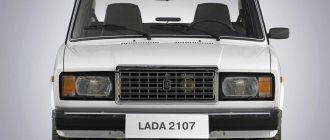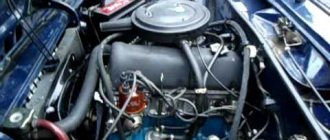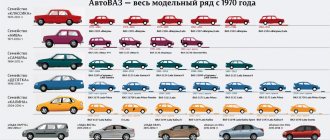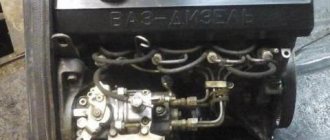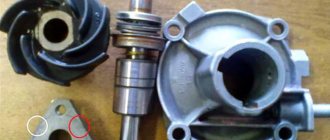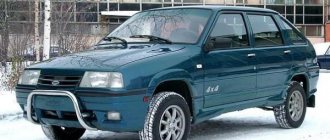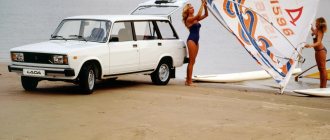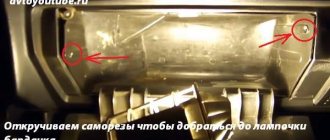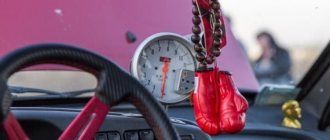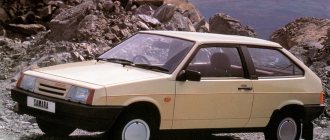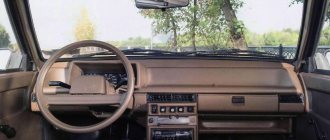VAZ classic - Expenses
In addition to the low price of a car upon purchase, “classics” also attract with affordable prices for repairs and maintenance . Spare parts and consumables for Lada cars are as cheap as possible – there is simply nothing cheaper. At the same time, classics are the most common car in our country, their number is in the millions. The VAZ-2107 “seven” alone is registered for more than 1.7 million units. Therefore, buying spare parts for classics is not a problem at all, you don’t even need to order them - they are sold literally everywhere.
Since the Zhiguli was equipped with low-power engines up to 82 hp, insurance and taxes are quite inexpensive here. In a word, “classics” will definitely NOT ruin you.
You can buy a good Zhiguli in 2020 for 50-60 thousand rubles, and for 70 it’s quite possible to find a copy with an injection engine in perfect condition, after 1-2 owners. All competitors for this money will be in a deplorable state and, even if they are on the move, will require serious financial investments in the near future.
As for the issue of image, having become old and affordable, Zhiguli certainly lost its authority, but not completely. Many years ago, in a great country, they were so desirable that even now, a certain aura of solidity still remains around them. Therefore, a well-preserved “classic” still arouses interest and respect today.
As a result, friends, we come to the conclusion that today’s “classics” have many disadvantages and, in fact, one significant advantage - accessibility. Let's once again list the main pros and cons of the Zhiguli.
Flaws
- Low level of comfort and safety
- Low reliability and durability
- Rapid aging and loss in value
Advantages
- Wide choice when buying, liquidity when selling
- Availability of consumables, spare parts, maintenance and repairs
- Cheap insurance and tax
Of course, today this is no longer a car for everyone, but then who will it suit? “Classic” is a good option for short, leisurely trips, over short distances, for example in a village, town or small town. If you have bad roads in your area, this is exactly her element. Well, young drivers love the “classic” for its affordable tuning and the fact that it can drive sideways.
© Kak-Kupit-Auto.ru
Links: zr.ru
What kind of bird is Troika?
This Zhiguli model received the VAZ-2103 index.
Popularly, thanks to the last digit of this index, it was immediately called Troika. Production of the Troika was initially planned to begin at the very beginning - in parallel with the production of the VAZ-2101. If the latter was an improved copy of the Fiat 124, then the Troika was supposed to be an even more improved copy of the Fiat 125. However, then the majority of the secretaries of the Central Committee decided that a car, costing almost 60 of the then salaries, would not be in effective demand, but the rush demand for the VAZ-2101 refuted these fears.
| Troika in the GDR Troika later issues The Three differs from the Six in appearance by its characteristic rear lights. The Troika's interior compared favorably with the penny one |
The fears of the Soviet leadership, it seemed, were not in vain: the initial retail price of the Zhiguli VAZ-2101 GAZ-21 cost back in 1965
. Of these 5,620 rubles, 120 were for the domestic radio receiver A-370, which, by the way, could have been abandoned, but which almost no one refused; on the contrary, everyone independently drilled an inch hole in the left front wing for the AR-108 antenna and , following the instructions, we spanned both the antenna and the receiver itself to the car.
However, Soviet workers were not at all embarrassed by the fact that with the average salary in 1970
at 115 rubles 17 kopecks a ruble, it was possible to save up for a Zhiguli only by saving 23 salaries. Many, by the way, did just that: the salary of one of the spouses went to food, and the salary of the other was put aside for a savings book, and after an average of three and a half years, even the most honest of the Soviet people could thus save up for the coveted car. What can we say about speculators, shop workers and so-called irrigators? In those days, irrigators were those who, buying, for example, watermelons at the Arys station (the cheapest watermelons were there), took them to Barnaul, Krasnoyarsk or even Irkutsk and sold them there with a northern coefficient.
This process was called watering, and a lucky waterer could earn money on a VAZ-2101 in one watering season. That is why the effective demand for Zhiguli turned out to be higher than predicted, which is why the Communist Party and the Soviet government decided in 1972 to give the command to the Volzhsky Automobile Plant to launch production of an improved and more comfortable modification of the Zhiguli with improved dynamic and speed characteristics. How was Troika different from Kopeika? Let's start, as always, with the appearance.
The most striking external difference was that instead of two headlights, the Troika had four - two on each side. At the same time, the inner headlights lit up only when the high beam was turned on, and the outer ones - both when the low beam and high beam were turned on. The bulbs in both headlights were the same, but on the internal ones the current was supplied only to the 45-watt high beam spiral. Another external difference was the taillights. At Kopeika, the orange and red parts of the rear lights were divided in half horizontally. At the same time, the red half of the left lantern was on the right, and the right half was on the left. The Troika had the orange part on top and the red part on the bottom. By the way, the rear lights later became the external sign by which the Troika began to be distinguished from the later Six, which at the time of its appearance in 1976 already cost 9,100 rubles. In addition, the Troika also had a reversing light. It was suspended under the rear bumper and lit up when reverse gear was engaged. It would light up if the outside lights were turned on. But the alarm lights for open front doors came on not only when the exterior lighting was turned off, but even when the ignition was turned off.
With the same wheelbase as the Kopeika - 2424 mm - the length of the Troika was 4116 mm instead of the penny 4073. The width of the Troika, contrary to the widespread but erroneous opinion that it was wider than the Kopeika, was the same 1611 mm and neither more than a millimeter.
The Troika had no less differences from the Kopeika in the interior. Start, for example, with the dashboard. Instead of the rectangular scale familiar to Soviet motorists, there was a round speedometer in the center of the dashboard and, to the left of it, a round tachometer of the same diameter. The latter, by the way, was used on domestic cars for the first time. In addition, the Troika had an analog clock on the front panel. A folding armrest appeared in the rear seat. The receiver, which was offered as an option on Kopeyka, became part of the standard package. Moreover, the receiver was already different: instead of the A-370, which worked only on long and medium waves, the new A-271 receiver could also receive ultrashort waves. But the most interesting thing was that the Troika had an anti-theft device, which later migrated as an option to the Kopeika itself. To activate it, it was necessary to turn the key to the parking position before removing the key. In this case, after removing the key from the ignition switch, the steering wheel lock was activated. The most significant difference from the Kopeyka was contained inside, under the hood. The fact is that the Troika had a larger and, accordingly, more powerful engine than the one installed on the Kopeyka. If the latter had an engine volume of 1197.625 cubic meters with a cylinder diameter of 76 mm and a piston stroke of 66 mm. cm, then the Troika’s piston stroke in the engine was increased to 80 mm. Thus, the engine displacement reached 1451.667 cubic meters. cm, which made it possible to call this engine a one and a half liter engine. Unlike the penny engine, which produced 62 hp at 5600 rpm, the Troika’s engine power at the same speed according to GOST corresponded to 77 horsepower. Therefore, the Troika accelerated to hundreds not in 22 seconds, but in 19. The maximum speed was also higher - 150 km/h instead of 140. In order to maintain the same compression ratio of 8.8 units in the engine, it was necessary to increase the volume of the combustion chamber. Otherwise, the compression ratio would reach 10.7 units, which would lead to the need to switch to 95th gasoline, which, unlike 93rd, which then cost 9.5 kopecks per liter in 1972, would cost as much as 15 kopecks if would, of course, go on sale freely. Gasoline prices, by the way, were of great importance even then. Even a difference of one and a half kopecks per liter forced Zhiguli owners to install an additional gasket between the head and the block, thereby reducing the compression ratio and losing 8 hp. power, get the opportunity to fill in 76th gasoline instead of 93rd. The first day of April 1977 will remain a black day for all Soviet motorists. That day, the price of gasoline doubled, and almost half of the motorists got a second gasket. What can we say about those times when, since 1982, gasoline began to cost 40 kopecks? Then the 76th also went up in price. It began to cost 30 kopecks. The 72nd was nominally worth 24, but it was almost impossible to buy it. Since then, many of the Zhiguli owners have already bought gasoline not at gas stations, but from drivers of state-owned 130 ZiLs, who, as you know, drove a 76. At current prices this already corresponded to 200 tenge per liter. And you say that gasoline is expensive these days. The gearbox was the same as that of Kopeyka. However, the final drive ratio was different - 4.1 instead of 4.3. This made it possible, with a larger and more powerful engine, to consume half a liter less fuel per 100 km than on the VAZ-2101. Troika's brakes have also become more reliable. This reliability was increased due to the installation of an additional vacuum amplifier. The Troika was produced from 1972 to 1976, until it was replaced in production by the very similar Six. However, for many years many motorists preferred the used Troika to the new Six.
Cool Troika! + Video Bonus - logbook of the 1976 Lada 2103 “DREAM” on DRIVE2
Little text (here are the details), a lot of photos :)Opening of the GaragePro car studio.
There were sooooo many people taking pictures and being photographed, I still see photos of people I don’t know on social networks. I was pleasantly surprised that there were quite a few girls among them, I definitely didn’t expect this
Fariz, thanks for the photo!
Don’t forget to subscribe, there are interesting photos and video sets ahead, and, expected by many, a detailed story about how much it cost. Thank you for your attention!
And here is the video, watch in HD :) Shot last year with friends, it doesn’t carry much meaning, the gaps haven’t been set yet, the sidelights are still crooked, the rear number plate is not square...
Enjoy watching!
P.S. No matter what anyone says, I like this three-piece stance, it looks daring
Issue price: $1,000,000
Lada 2103 Troika-diplomat on DRIVE2.RU
History of my car: this three was purchased from my grandfather in 2013. The car was completely factory-built, with chrome-plated hubcaps and a triple grille. A year later, we sold it to my father’s friend for almost 2 times the price. But not about that. This friend rode the troika for a bit and parked it in the yard. It stood in the yard for a year and a half, during which the paint on the roof, hood, and trunk faded. Some scumbags removed the bumpers, grille, and lights (back and front), but did not get into the interior. A friend decided to sell it to us for a quarter of the purchase price. Naturally, we bought it back. In two months, my father and I: repainted it, bought bumpers, lights, a six-wheel grille, installed gas. Now it is used for its intended purpose.
This is the story) Good luck to everyone on the roads)
- Engine 1.6 petrol (80 hp)
- Manual Transmission
- Rear drive
- The car was produced in 1976 and was purchased in 2016.
- Lada 21035 has been produced since 1973
- License number E820ME 36
Six months on the site Description written 5 months ago
